Are your CRMs being flooded with duplicates as a result of the HubSpot-Salesforce sync? It can be a huge headache to manage.
Duplicate records are not just technical nuisances; they have real implications for businesses. Duplicates can lead to inefficient sales processes, skewed marketing analytics, and compromised customer experiences. Moreover, the effort required to manually merge these records is not only time-consuming but also prone to errors, leading to further data integrity issues.
Unfortunately, fixing duplicates is very difficult. To stop a record from being synced, you have to fix the creation of duplicates at the source—and there may be many sources. This is not easy, but it’s worth the effort. By fixing the issues surrounding duplicates and the two-way HubSpot-Salesforce sync, companies can ensure that their sales, marketing, and support teams are working with clean, reliable data, enabling more targeted and effective customer interactions.
In this article, we'll cover how these duplicates impact your business, where those duplicates come from, and share a solution for ensuring that duplicates in HubSpot are deduplicated before the records are synced with Salesforce.
The Domino Effect of Duplicates With a HubSpot-Salesforce Sync
When duplicates arise as a result of a two-way sync between HubSpot and Salesforce, their impact can be far-reaching. The differences in duplicate detection rules between the two platforms leads to a cascade of challenges that affect various facets of an organization. Here's how these duplicates can detrimentally impact a company:
- Increased operational costs: Every duplicate record requires manual review and merging. This is an arduous undertaking, and it’s one that may need to be doubled. If the sync is broken for any duplicate records, you’ll need to manually review and merge them in both HubSpot and Salesforce.
- Inaccurate reporting and analytics: Duplicates skew data analytics, leading to misleading insights. The sync magnifies this distortion across both CRMs, affecting strategic decisions based on flawed data analysis from both marketing and sales perspectives.
- Wasted marketing spend: Marketing efforts may be duplicated for the same contact in both CRMs, resulting in unnecessary expenditure on campaigns that target the same individual multiple times.
- Sales inefficiencies: Due to duplicate entries, sales representatives might pursue the same lead multiple times in one or both CRMs, wasting valuable time and resources that could be directed towards new opportunities.
- Degraded customer experience: Inconsistencies in customer interactions can occur when different team members access duplicate records across HubSpot and Salesforce. This can lead to repetitive communication or conflicting messages.
- Difficulty in tracking customer interactions: With duplicates spread across two systems, it becomes challenging to maintain a cohesive view of customer interactions, history, and preferences, complicating personalized outreach efforts.
- Lowered trust in data: The presence of duplicates undermines confidence in the CRM data's accuracy, leading to hesitancy in leveraging this data for critical business decisions.
In a two-way sync setup, the impact of duplicates is not just doubled—it's compounded. The repercussions extend beyond simple data management issues, affecting strategic decision-making, customer satisfaction, and ultimately, the bottom line.
Now let’s look at how companies are currently dealing with this issue and examine some of the pitfalls of that approach.
How Companies Deal With Duplicates With an Active HubSpot-Salesforce Two-Way Sync
In the face of duplicates caused by a two-way sync between HubSpot and Salesforce, companies often find themselves resorting to manual identification and merging of duplicate records.
Manual merging of contacts in HubSpot and Salesforce is a time and labor-intensive process—especially when you have a lot of duplicates. Preventing the duplicates at their source may seem like a better option than spending lots of time cleaning them up—but duplicate records can have many sources, and accounting for them all is very difficult.
Sources of Duplicate Data
- Manual data entry: Human error during manual entry of contact details, accounts, or leads can result in duplicates. This includes typos, different spellings of the same name, or entering the same person or company more than once.
- Importing data: Importing data from other systems, spreadsheets, or databases without a matching or deduplication process in place can cause existing records to be duplicated.
- Integration with other systems: CRMs often integrate with email, marketing automation, sales, and customer service platforms. If these systems have duplicate records or if the integration does not check for duplicates when syncing data, duplicates can be introduced into the CRM.
- Web forms and lead generation tools: Leads generated from web forms, landing pages, or social media can create duplicates if the same contact submits information multiple times or if similar entries are made by different sources.
- Decentralized data entry standards: Without uniform data entry standards or guidelines across an organization, different departments or individuals might enter data in varied formats, leading to inconsistencies and duplicates.
- Automated data creation: Some CRM systems automatically create new records based on incoming emails or other triggers. If these automation rules are not carefully set, they can lead to the creation of duplicate entries.
- Sales and marketing activities: Sales teams entering new leads without checking for existing records or marketing campaigns that add contacts from various sources can result in duplicates if there's no cross-referencing.
- Customer-initiated changes: When customers or clients update their information via customer portals or direct requests and use a different email address than the one you have on file, a duplicate may be created.
- Mergers and acquisitions: When companies merge or acquire others, consolidating CRMs without a solid strategy can introduce duplicates if there's overlapping data.
As you can see, duplicates can enter your synced HubSpot and Salesforce systems through many avenues. Blocking them all is an uphill battle. And when you’re dealing specifically with HubSpot companies and Salesforce accounts, the situation becomes even more complicated. Let’s look at why that is.
Dealing With Duplicate HubSpot Companies and Salesforce Accounts
When it comes to HubSpot companies and Salesforce accounts, deduplication becomes even more complex due to the active sync. To effectively deduplicate, you must:
- Pause the two-way sync: Temporarily disable the sync to prevent the creation of new duplicates during the deduplication process.
- Deduplicate: Carefully merge duplicates in both HubSpot and Salesforce, ensuring that the synced record is the master record resulting from the merge in both platforms. This step requires meticulous attention to ensure that when the sync is reactivated, it recognizes the merged record as the same entity across both CRMs.
- Reactivate the sync: Once deduplication is complete and verified, re-enable the two-way sync between HubSpot and Salesforce.
This manual process is often disruptive, as it may require halting CRM access during business hours or allocating time outside of regular operations, such as weekends, to avoid interrupting business activities. Furthermore, the temporary suspension of the sync could lead to operational delays and potential data inconsistencies that need to be addressed once the sync is restored.
To many companies, it may seem that there are no good options for dealing with these sync-created duplicates. They just find themselves using the conventional manual merging features in both platforms to merge what they can, deal with the headaches that come with the duplicates they cannot fix, and try to keep some semblance of organization and cleanliness in their CRM as best as they can.
But what if there were a solution that could help you ensure that duplicates created in HubSpot never reached Salesforce to begin with? You’re in luck.
Identify and Merge Duplicates in HubSpot Before They Sync With Salesforce, Using Insycle
Navigating the complexities of managing duplicates across HubSpot and Salesforce can be a daunting task.
You may never be able to completely stop duplicates from entering HubSpot and then being synced to Salesforce. However, you can do something to ensure that the duplicates created in HubSpot are identified and merged before syncing to Salesforce: use HubSpot’s inclusion lists and Insycle's integration with HubSpot Workflows. Let’s look at how this works.
Step 1: Create a Custom Field to Tag Contacts As Sync-Ready
To start, we need to create a custom field for contacts. This field will be updated once the deduplication takes place, triggering the contact being added to the Salesforce inclusion list, and syncing with Salesforce.
Navigate to Contacts > Contacts > Actions > Edit Properties
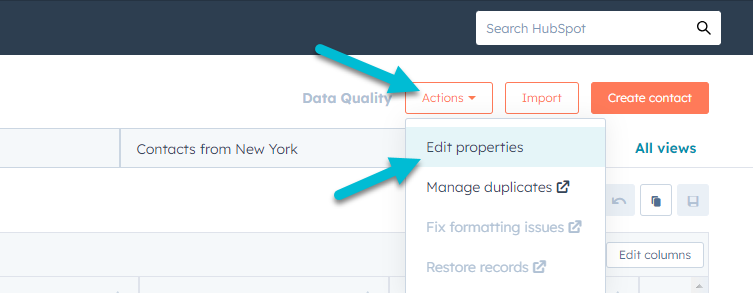
Then, click on the orange Create Property button. You can name the field something like "Salesforce Sync Ready" so that it is clear what the purpose of the field is.
In the second property creation screen, you'll be asked to choose your field type. While most field types would work, the Single Checkbox field type is a great choice because it gives us the "Yes" and "No" inputs automatically, and minimizes potential errors.
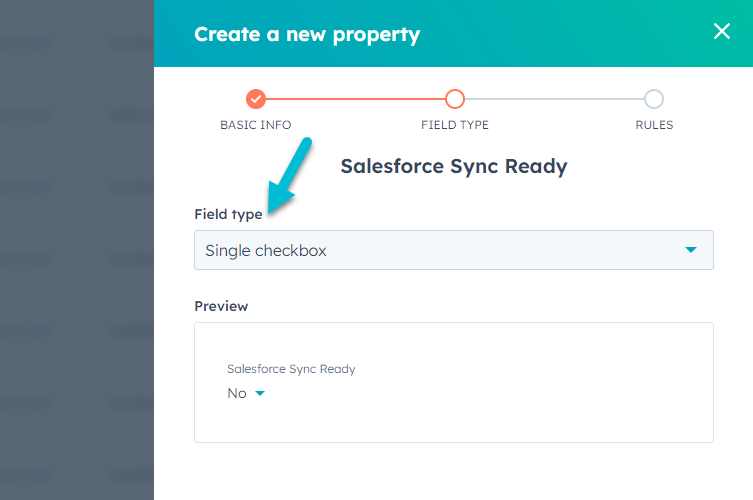
With this custom field created, we are now ready to create the inclusion list that will use this field as a trigger.
Step 2: Create an Inclusion List for Syncing Contacts To Salesforce After Deduplicating
Inclusion lists allow you to sync only certain aspects of your HubSpot database with Salesforce, rather than syncing the entire database. For the purpose of limiting duplicates, you can use an inclusion list that includes only records that have been deduplicated before syncing with Salesforce.
To do this, you’ll have to create your inclusion list and then change your HubSpot-Salesforce settings to only sync with that list.
Here is how you can create an inclusion list:
First, create a new active list by navigating to Contacts > Lists > Create Lists.
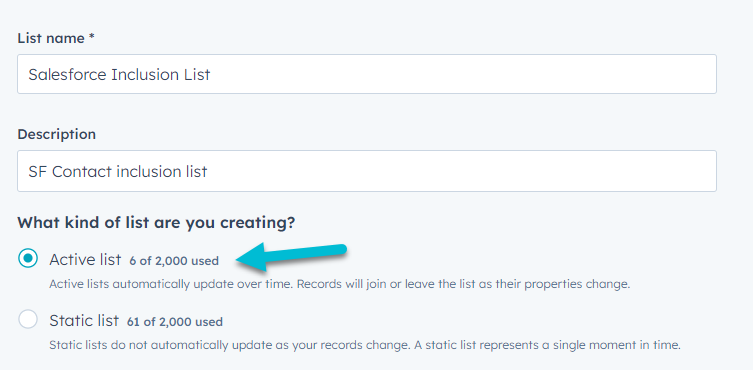
Click the Next button. Now we have to select the filter that tells HubSpot what contacts will be added to this list. Click the Add Filter button on the lefthand side of the screen.
Then click Contact Properties, type Salesforce into the search box and select your custom Salesforce Sync Ready field that we created in the previous step.
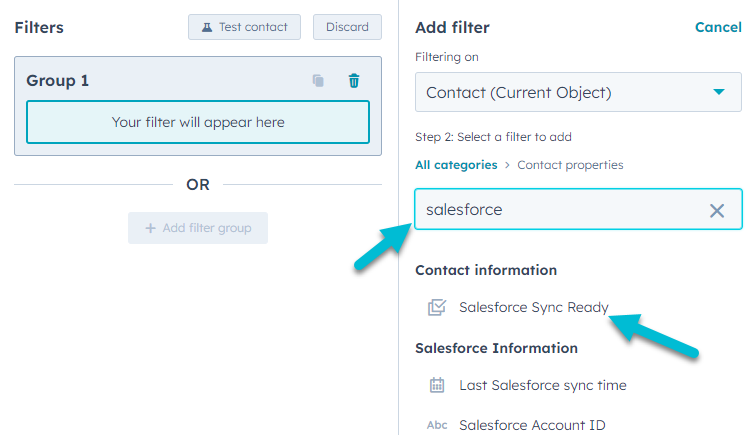
There, instruct HubSpot to add contacts to this active list when this field includes "Yes." Then click the Save button on the top right-hand part of the screen.
Now we will set the list as an inclusion list.
Then, click on the Marketplace icon on the main navigation strip, and then click on Connected Apps.
Then, select the Salesforce app and navigate to the Contacts tab, where you can add your inclusion list under the ”Limiting What Syncs” section.
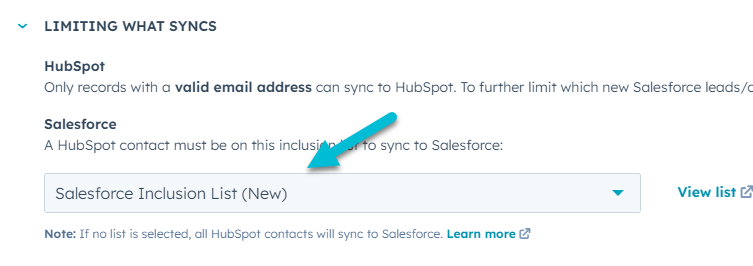
Now, let’s create our Insycle Recipe, which we will inject into our workflow to deduplicate contacts before they sync with Salesforce.
Step 3: Create your Insycle Dedupe Recipe
A Recipe in Insycle is a collection of templates that are bundled together, and executed in a specific order.
A template consists of your saved settings within a module. You may have many saved templates in a single module.
For example, in the Merge Duplicates module, you might have several templates that identify and merge duplicates in different ways:
- Template 1: Identify and merge duplicate contacts by similar first name and last name, and similar email.
- Template 2: Identify and merge duplicate contacts by using similar match to match the first and last name, and using exact match to match the phone number.
- Template 3: Identify and merge duplicate contacts by exactly matching first name and last name, similarly matching email domain, and similarly matching company name.
Then, you can bundle these three templates into a Recipe, which can be inserted into a HubSpot workflow.
To do this, select the Operations drop-down menu, then Recipes.
Then, add your Merge Duplicates templates to your Recipe by clicking on the Template button.
Then, click the floppy disk icon to save your Recipe.
Next, set up the workflow to ensure that contacts are only synced with HubSpot after deduplication with Insycle takes place.
Step 4: Create a HubSpot Workflow To Dedupe New Contacts and Add Them To the Salesforce Inclusion List
Start by creating a HubSpot workflow by going to Automation > Workflows. This workflow should be triggered when a new contact object is created.
Add the trigger module.
Then, add your Insycle deduplication Recipe to your workflow following the delay.
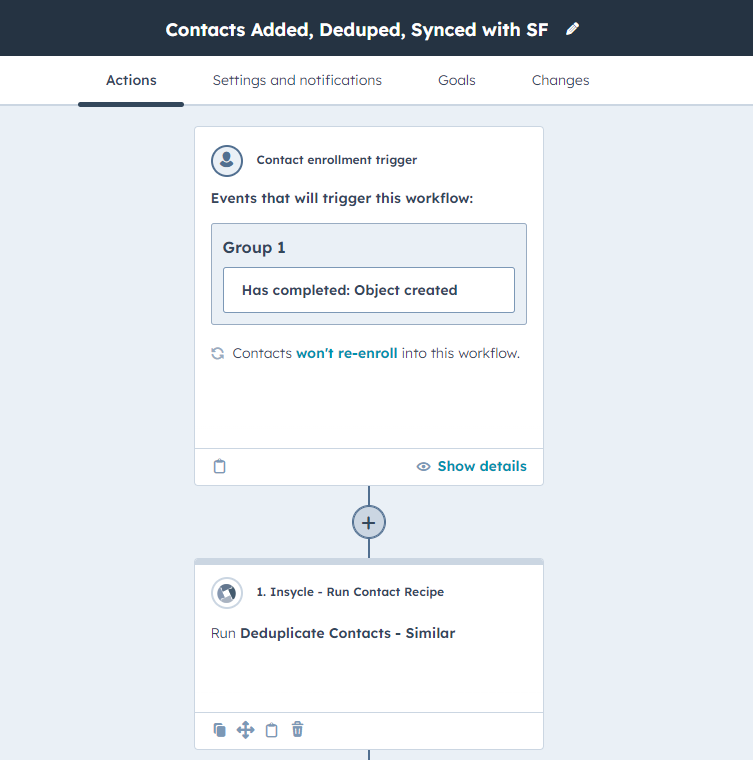
Additionally, you aren't limited to a single Insycle Recipe here. You could not only dedupe these contacts, but also clean them up in a variety of ways before syncing with Salesforce.
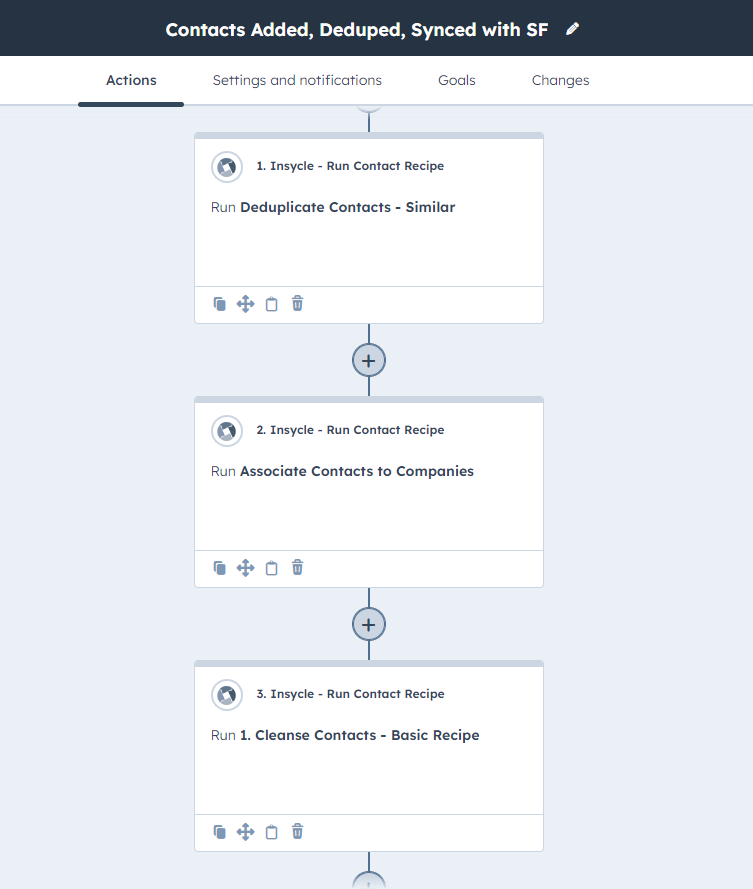
You can inject Insycle Recipes by selecting the Insycle Data Management App from the Connected Apps section on the left-hand menu on your workflow editing screen.
Then, now the records have been deduplicated and are ready to be synced, let's add a module for updating the Salesforce Sync Ready field. You can find the Set Property Value module in the CRM category on the lefthand menu on the Workflow editor.
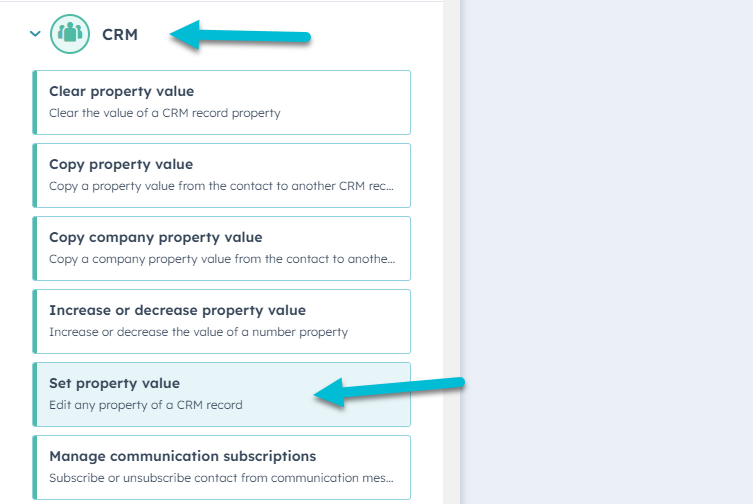
Here, instruct HubSpot to update the custom Salesforce Sync Ready field to Yes and click Save.
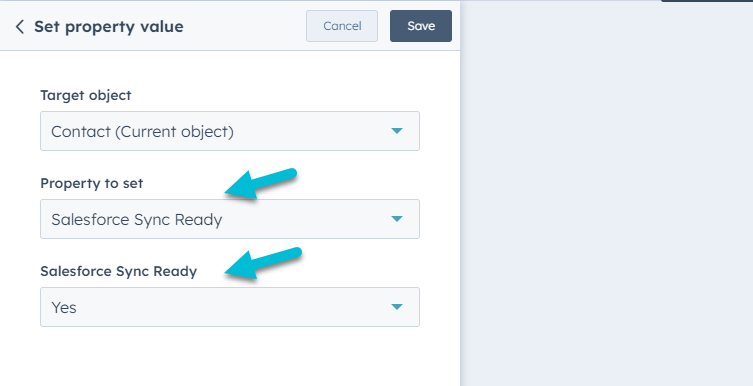
With this Workflow, your contact will be created, then deduplicated by Insycle, then once the custom field is updated, the contact will automatically be enrolled in your inclusion list that syncs with Salesforce.

Once the workflow has run, you can verify that enrolled contacts have been added to the inclusion list and synced with Salesforce, allowing you to avoid replicating HubSpot duplicates on your synced Salesforce CRM.
Harmonizing Your CRM Data: The Insycle Advantage
In the complex dance of managing customer data across multiple CRM platforms, Insycle is the perfect partner, ensuring that your steps are always in sync and that your duplicates are well-managed.
But Insycle's capabilities extend far beyond mere deduplication. Insycle is a comprehensive data management solution offering a range of features that enhance CRM data quality across the board. From cleaning and standardizing data to automating complex workflows, Insycle provides the tools necessary for businesses to fully leverage their CRMs.
We invite you to explore how Insycle can revolutionize your approach to CRM data management for synced HubSpot and Salesforce ecosystems.






